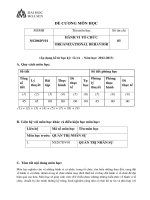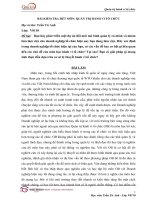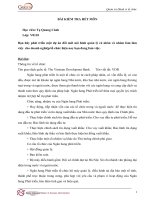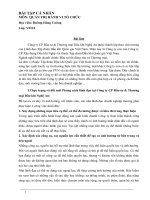Đề cương trắc nghiệm Hành Vi Tổ Chức (Organizational Behavior) CHƯƠNG 10
Bạn đang xem bản rút gọn của tài liệu. Xem và tải ngay bản đầy đủ của tài liệu tại đây (46.98 KB, 15 trang )
Chapter 10: Decision Making and Employee
Involvement
10-1. According to the general model of decision making, what should
occur Immediately after identifying the problem?
a. Develop alternative solutions.
b. Choose the best solution.
c. Choose the best decision style.
d. Evaluate decision outcomes.
e. None of these.
The question was not answered. The correct answer
is "c". (Coaching responses are only available for answered questions)
10-2. Any nonroutine situation in which employees much search for
alternative solutions is called:
a. A nonprogrammed decision
b. Satisficing.
c. An implicit favourite.
d. Postdecisional justification.
e. Escalation of commitment.
The question was not answered. The correct answer
is "a". (Coaching responses are only available for answered questions)
10-3. What decision making process allows people to select the
preferred solution without the need to identify or evaluate alternative
choices?
a. Scenario planning
b. Programmed decision.
c. Escalation of commitment.
d. Satisficing.
e. Systematic evaluation
The question was not answered. The correct answer
is "b". (Coaching responses are only available for answered questions)
10-4. Which of these is NOT an economic assumption about choosing
decision alternatives?
a. Decision-makers choose the alternative with highest payoff.
b. Decision-makers evaluate alternatives sequentially.
c. Decision-makers use goals that are clear, compatible, and agreed
upon.
d. Decision-makers process factual information.
e. All of these are economic assumptions about choosing decision
alternatives.
The question was not answered. The correct answer
is "b". (Coaching responses are only available for answered questions)
10-5. Which of the following is NOT an organizational behaviour
finding about choosing decision alternatives?
a. Decision makers evaluate alternatives against an implicit favourite
alternative.
b. Decision makers have limited information-processing abilities.
c. Decision makers evaluate all alternatives simultaneously.
d. Decision makers choose the alternative that is good enough.
e. Decision makers process perceptually distorted information.
The question was not answered. The correct answer
is "c". (Coaching responses are only available for answered questions)
10-6. Which of the following refers to the tendency to select a solution
that is "good enough" rather than "the best"?
a. Post-decisional justification
b. Satisficing
c. Selective attention
d. Evaluation apprehension
e. Maximizing
The question was not answered. The correct answer
is "b". (Coaching responses are only available for answered questions)
10-7. Which of the following refers to the ability to know when a
problem or opportunity exists and to select the best course of action
without conscious reasoning.
a. Satisficing
b. Tacit knowledge
c. Intuition
d. Selective attention
e. Post-decisional justification
The question was not answered. The correct answer
is "c". (Coaching responses are only available for answered questions)
10-8. Which of these statements about intuition is TRUE?
a. Intuition relies on escalation of commitment to make decisions.
b. Intuition is more likely to be found in men than women
c. Intuition is a trait that people acquire mainly through heredity
d. Intuition is a mythical belief that we can make decisions without
thinking, whereas it does not exist in reality.
e. Intuition relies on tacit knowledge to make decisions.
The question was not answered. The correct answer
is "e". (Coaching responses are only available for answered questions)
10-9. Which of these is the tendency to repeat an apparently bad
decision or allocate more resources to a failing course of action?
a. Programmed decision
b. Satisficing
c. Selective attention
d. Post-decisional justification
e. Escalation of commitment
The question was not answered. The correct answer
is "e". (Coaching responses are only available for answered questions)
10-10. Closing costs and self-justification are known causes of:
a. Satisficing
b. Programmed decision making
c. Selective attention
d. Escalation of commitment
e. Intuition
The question was not answered. The correct answer
is "d". (Coaching responses are only available for answered questions)
10-11. Separating decision choosing from those who evaluate the
subsequent effectiveness of the decisions tends to:
a. reduce escalation of commitment.
b. increase satisficing.
c. discourage intuition.
d. increase the use of programmed decision making.
e. decrease satisficing.
The question was not answered. The correct answer
is "a". (Coaching responses are only available for answered questions)
10-12. When a bank teller makes a service improvement suggestion to
the branch manager, it represents which form of involvement?
a. Informal
b. Statutory
c. Indirect
d. Formal
e. High involvement
The question was not answered. The correct answer
is "a". (Coaching responses are only available for answered questions)
10-13. Which of these refers to a form of employee involvement
required by some governments that typically operates at both the work
site as work councils and corporate level as supervisory boards?
a. Open book management
b. Informal involvement
c. Direct involvement
d. Gainsharing
e. Codetermination
The question was not answered. The correct answer
is "e". (Coaching responses are only available for answered questions)
10-14. Which of these represent the lowest level of employee
involvement?
a. SDWTs
b. Communities of practice
c. Selective consultation
d. Gainsharing
e. Open book management
The question was not answered. The correct answer
is "c". (Coaching responses are only available for answered questions)
10-15. Which of these are informal groups of people who are connected
by their interest in a particular field of knowledge?
a. Quality circles
b. Codetermination groups
c. Statutory groups
d. Communities of practice
e. Self-directed work teams
The question was not answered. The correct answer
is "d". (Coaching responses are only available for answered questions)
10-16. Work groups that complete an entire piece of work requiring
several interdependent tasks and have substantial autonomy over the
execution of these tasks are called
a. quality circles.
b. self-directed work teams.
c. coalitions.
d. open book teams.
e. low involvement teams.
The question was not answered. The correct answer
is "b". (Coaching responses are only available for answered questions)
10-17. Employee involvement works better in:
a. High power distance cultures.
b. Highly individualistic cultures.
c. In high command-and-control cultures.
d. Social loafing cultures.
e. Low power distance cultures.
The question was not answered. The correct answer
is "e". (Coaching responses are only available for answered questions)
10-18. To determine the optimal level of employee involvement, we
need to know:
a. Whether employees have sufficient information to make the decision
alone
b. Whether the problem is well structured (i.e., a programmed decision).
c. Whether you have sufficient information to make the decision alone.
d. All of the above
e. Only 'a' and 'c'
The question was not answered. The correct answer
is "e". (Coaching responses are only available for answered questions)
TRUE or FALSE
10-1. The last step in the general decision making model is to make the
decision.
True / False
The question was not answered. The correct answer
is "False". (Coaching responses are only available for answered
questions)
10-2. A non-programmed decision follows standard operating
procedures.
True / False
The question was not answered. The correct answer
is "False". (Coaching responses are only available for answered
questions)
10-3. Two factors that interfere with identifying problems and
opportunities are the decision-maker's imperfect perceptions and
diagnostic skills.
True / False
The question was not answered. The correct answer
is "True". (Coaching responses are only available for answered
questions)
10-4. In organizations, all decisions are based on organizational
objectives not the personal goals of the decision-maker.
True / False
The question was not answered. The correct answer
is "False". (Coaching responses are only available for answered
questions)
10-5. The higher the level of employee involvement, the less power
people have over the decision process and outcomes.
True / False
The question was not answered. The correct answer
is "False". (Coaching responses are only available for answered
questions)
10-6. Statutory involvement is more widespread in Europe, where many
countries have codetermination laws.
True / False
The question was not answered. The correct answer
is "True". (Coaching responses are only available for answered
questions)
10-7. A unique element of open book management is that it encourages
employees to think of financial performance as a game that they can
play and win.
True / False
The question was not answered. The correct answer
is "True". (Coaching responses are only available for answered
questions)
10-8. Traditional economic theory assumes that decision makers
evaluate alternatives against a set of absolute standards.
True / False
The question was not answered. The correct answer
is "True". (Coaching responses are only available for answered
questions)
10-9. Intuition is the conduit through which people apply their tacit
knowledge.
True / False
The question was not answered. The correct answer
is "True". (Coaching responses are only available for answered
questions)
10-10. The formality of employee involvement refers to the extent that
employees participate through representation of peers..
True / False
The question was not answered. The correct answer
is "False". (Coaching responses are only available for answered
questions)
10-11. Self-directed work teams represent the lowest level of employee
involvement.
True / False
The question was not answered. The correct answer
is "False". (Coaching responses are only available for answered
questions)
10-12. Sociotechnical systems theory helps us to determine how to
create successful self-directed work teams.
True / False
The question was not answered. The correct answer
is "True". (Coaching responses are only available for answered
questions)
10-13. Employee involvement works better in cultures with high
individualism.
True / False
The question was not answered. The correct answer
is "False". (Coaching responses are only available for answered
questions)
10-14. When employee involvement is desirable, leaders need to
recognize and overcome three barriers: cultural differences, synergy, and
empowerment.
True / False
The question was not answered. The correct answer
is "False". (Coaching responses are only available for answered
questions)
10-15. According to the Vroom-Jago decision tree of employee
involvement, the optimal level of employee involvement depends on
whether subordinates will disagree over the preferred solutions..
True / False
The question was not answered. The correct answer
is "True". (Coaching responses are only available for answered
questions)









